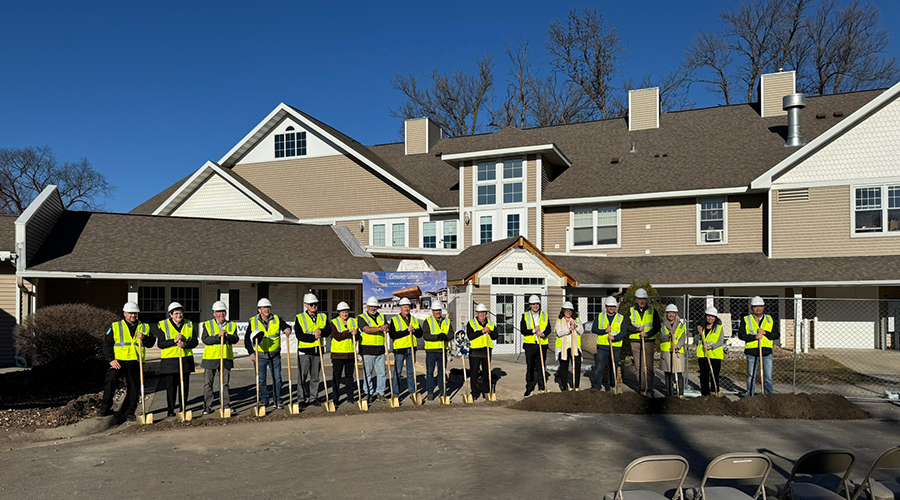Building resilience and continuity of operations are important challenges for every facility. It is especially important for critical medical professional buildings and hospitals because problems such as leaks, mold growth and building comfort issues can disrupt operations and have significant negative impact.
Building enclosure commissioning (BECx) is a quality-focused process that helps healthcare facility managers ensure constructed building enclosure systems meet the design criteria and the owner’s requirements as described in the contract documents. The BECx process includes much more than typical oversight during the pre-design, construction, and post-occupancy phases of a medical professional building or hospital.
BECx provides a constant loop from an owner’s requirements, design provisions, quality control, quality assurance and closeout, so it can be used for new construction or for remediation and repair projects. This harmonization of the owner’s requirements, construction cost and schedule and project delivery optimizes the building’s performance, cost, durability and maintenance.
BECx in action
Three scenarios exist when the BECx process is typically warranted:
New construction and major renovation. BECx verifies that new construction or major renovation of a building’s enclosure systems are designed, constructed and started up for optimized performance. Carried out at the time of construction or renovation, the BECx agent provides a perspective independent of the design professionals and contractors.
Typical steps in the BECx process include:
- predesign services, such as developing owner’s requirements
- construction documentation review
- verification of installed systems through routine construction observations
- verification of performance testing
- building and Energy Conservation Code compliance review
- issue tracking and closeout
- training for building operating personnel.
Planned routine maintenance and troubleshooting. Recommissioning performed by maintenance personnel or commissioning agents when a building has previously been commissioned is typically prompted by the owner through tracking increasing energy costs, operational problems, comfort or other complaints by occupants.
Recommissioning is usually recommended at routine intervals to preserve the operational benefits and energy efficiency realized in previous commissioning or retrocommissioning of a building because it reduces the potential for unexpected or unplanned repairs and replacements. It also verifies that maintenance personnel are adequately trained and have documentation to reduce building maintenance and achieve optimum energy use and indoor comfort.
Retrocommissioning. This multi-step process goes beyond day-to-day building maintenance and resolving operational problems through diagnostic assessment of the building enclosure, mechanical HVAC systems, lighting and controls. Operational and occupancy changes might require retrocommissioning of one or more building systems.
This process helps the facility manager identify and meet targeted energy efficiency and performance requirements through benchmarking. Retrocommissioning provides a basis for a master of findings that, if implemented, can reduce energy and water use costs and improve thermal and operational performance.
Spotlight on challenges
BECx has challenges that differ from commissioning other building systems, according to the National Institute of Building Sciences (NIBS):
- The enclosure is designed and field-assembled from numerous materials with varying thermal and moisture resistive properties.
- Building enclosure materials are manufactured by differing companies for a specific function, assembled mostly on site one piece at a time by many different tradespeople working for several different contractors, often with minimal coordination.
- The work is performed in all possible weather conditions with the intention of meeting well-defined criteria for thermal, moisture resistance and building pressurization performance.
- The overall performance of the building enclosure usually cannot be verified until the entire building is completely enclosed. At this time, it is not possible to address problems related to system performance. To access a nonperforming subsystem or assembly can be very expensive.
NIBS concludes, “The most reliable means to achieve performance targets … is to assure that an expert or BECx agent, with technical knowledge of the design and installation of the systems … is integrated into the design and construction process to visually observe the installation of a statistical sampling of the work. Verification witness testing should be performed throughout the installation of the enclosure subsystems and components.”
The BECx process is unique in that it starts in the planning phase with a competent expert or BECx agent working with the owner and manager to clearly define success and document what the owner is trying to accomplish.
These statements and definitions are documented in the owner’s project requirements (OPR), which includes factors such as performance, cost, schedule and maintenance requirements. Performance requirements are critical and go beyond building code minimum requirements. Factors such as sustainability, durability, resilience and redundancy should be considered and clearly defined as these provisions are directly related to safe continuity of operations. Continual review of the OPR keeps project teams on track to deliver success for the building owner.
Construction considerations
During the construction process, the BECx team observes mockups and construction progress construction, and the team witnesses testing and verification processes. As testing failures and construction challenges inevitably occur, design modifications are regularly required.
Although this role is common for all construction projects, only the BECx process provides a standard roadmap for the way to address these issues. In typical building construction, response to changes or problems are generally limited and reactionary, resulting in isolated modifications that do not address the changes in performance or consider the full range of systems affected.
When a problem is identified during the BECx process, the project team reviews the OPR and design and will reopen aspects of the pre-construction process. As noted above, the BECx process provides a continual loop to align project requirements, design or modification provisions, quality control and assurance and closeout.
The BECx agent helps maintain accountability with issue tracking during the initial OPR, design phase and construction phase, and the agent will continue until every action item has been addressed and closed to the satisfaction of the project team. In addition to performing important coordination and administration, the BECx agent must be proficient in the types of performance testing performed during construction, such as window water testing, air leakage testing, infrared imaging, roof uplift testing, electronic leak detection and moisture scanning.
New technologies, such as drone imaging, LiDAR laser scanning, and augmented reality, are significantly improving construction quality and are developing rapidly. The BECx agent must assess their application, scope and limitations to ensure they are properly incorporated into the project delivery process.
When essential buildings such as those in the healthcare sector feature critical, high-performing systems, initiating a BECx program can give the owner and manager peace of mind that the investment, maintenance and operational plan for the facility will satisfy user experience, business continuity and energy efficiency standards.
Keith A. Simon, FAIA, is senior architectural consultant, principal and building enclosures practice lead with Terracon.

 Healthcare Is the New Retail
Healthcare Is the New Retail Bridgeway Behavioral Health Services Launches Campaign to Renovate Health Center
Bridgeway Behavioral Health Services Launches Campaign to Renovate Health Center Ground Broken for New North Dakota State Hospital
Ground Broken for New North Dakota State Hospital AI Usage for Healthcare Facilities
AI Usage for Healthcare Facilities Ground Broken on Pelican Valley Senior Living Modernization Project
Ground Broken on Pelican Valley Senior Living Modernization Project